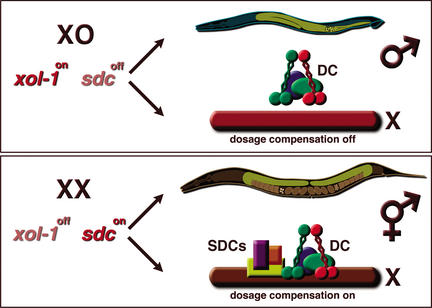Figure 1.
Genetic control of sex determination and dosage compensation in C. elegans. xol-1 is the primary sex-determination switch gene and the direct molecular target of the X-chromosome counting mechanism. (Top) Male (XO). High xol-1 activity specifies male fate by repressing the activity of sdc-1, sdc-2, and sdc-3 genes. Overt male sexual characteristics include a one-armed gonad (yellow) and a highly specialized tail used for mating. The dosage compensation machinery (colored ovals) does not bind to the X chromosome. Thus, X chromosome gene expression is unregulated (red chromosome). DC, dosage compensation complex (i.e., DPY-26, DPY-27, DPY-28, and MIX-1). (Bottom) Hermaphrodite (XX). Low xol-1 activity specifies hermaphrodite fate by allowing the activation of sdc-1, sdc-2, and sdc-3 genes. Overt hermaphrodite sexual characteristics include a two-armed gonad (yellow, with brown oocytes and embryos) and a tapered tail. The sdc-1,sdc-2, and sds-3 gene products (colored rectangles) recruit a large complex of dosage compensation proteins (DC, colored ovals) to both X chromosomes, repressing X gene expression by half (brown chromosome).

